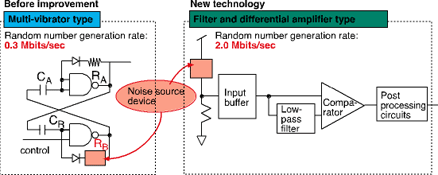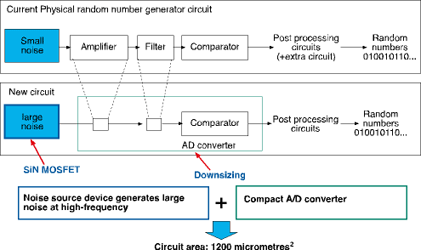
Toshiba has announced the development of a major advance in information security technology in the form of a physical random-number generation circuit that is said to achieve the world's highest output by area, and that generates random numbers at a data rate of 2 Megabits a second. The newly developed random-number generator (RNG) has a circuit size of only 1200 square micrometres but achieves the level of performance and reliability essential for integration into IC cards and mobile equipment.
The details of the technology were introduced at the recent IEEE International Solid-State Circuits Conference (ISSCC) 2008 in San Francisco. The new RNG technology adopts a compact analog-digital converter which effectively amplifies analog noise signals and converts them to digital random numbers. The technology also integrates a Toshiba-developed compact noise source device. This generates the noise signal by using stochastic physical phenomena of electrons trapped in the silicon nitride (SiN) layer of a transistor; the layer traps and releases high density electrons at a high generation rate. Toshiba also confirmed that the new RNG circuit is not subject to temperature dependence, a long-standing reliability issue for physical RNG.
Hacker-proof encryption is essential for secure information transfers in financial transactions and personal information exchanges. Many encryption algorithms rely on high quality RNG that eliminate periodicity in generated numbers. Existing cryptographic security technology for IC cards is based on pseudo-RNG algorithms, and is nearing its limitations as network technology advances.
The new physical RNG circuit relies on a nanometre-scale noise source device that is not affected by temperature. This device generates large noise signals at high frequency; the newly developed circuit then effectively digitises these signals.

Filter and differential amplifier type A-D converter
In its previous work on development of a compact RNG circuit, Toshiba employed a multivibrator circuit, where the noise source device was connected to the digitiser circuit in series. As a result, there was a trade-off between the magnitude of the noise and the generation rate; in order to increase the magnitude of the noise, resistance of the noise source device needs to be high, but this leads to a reduction in the circuit's generation rate.
The new technology employs a filter and differential amplifier with a comparator, which is separated from the noise source device. It can selectively extract the high frequency noise signals generated by the new device and achieve a random number generation rate approximately seven times higher than the multivibrator circuit: this increases performance to a practical level of 2 Mbps, against 0,3 Mbps with the earlier technology.

Downsized A-D converter
The improved circuit downsizes the A/D converter. In general, there is a trade-off in RNG: the smaller the noise source device, the larger the circuit area. The high frequency noise signals generated by the noise source device allow Toshiba to reduce the size of the A-D converter, and to reduce the entire RNG circuit area to 1200 square micrometres, including the noise source device. This is said to be 86,6% smaller than the next smallest physical RNG circuit yet announced.
No temperature dependence
Experimental tests in a range from -50 to 100°C have confirmed the high-quality randomness of the numbers generated. Results show that the generated numbers are not affected by temperature, verifying the possibility of stable generation of random numbers under the temperature conditions in which IC cards and mobile equipment are used.
Toshiba, supported by Japan's National Institute of Information and Communications Technology (NICT) will continue further development and improvement of the circuit, toward the practical use of the unpredictable, highly safe physical RNG in a few years.

© Technews Publishing (Pty) Ltd | All Rights Reserved